When it comes to software development , Agile methodology has emerged as a game- changer. Its iterative approach and emphasis on collaboration has make it a perfect choice for many development teams.
If you are new to agile application development, you might be wondering where to begin. Agile application development is not just a methodology , it’s a mindset. At its core, Agile emphasizes flexibility, collaboration and customer satisfaction.
Instead of following a rigid plan, Agile teams work in iteractive cycles allowing for continuous improvement and adaptation.
According to KPMG report, 91 % of the organizations state that its strategic priority to adopt Agile. And project initiated with Agile enjoy upto 64% of success rate.
One of the best thing about Agile development is it allow teams to adapt to changing requirements, ensuring the end product aligns with the client’s vision.
In this blog, we shall be discussing, what is Agile application development and its benefits and the agile app development process. With this being said, let’s dive right in.
Understanding Agile Application development
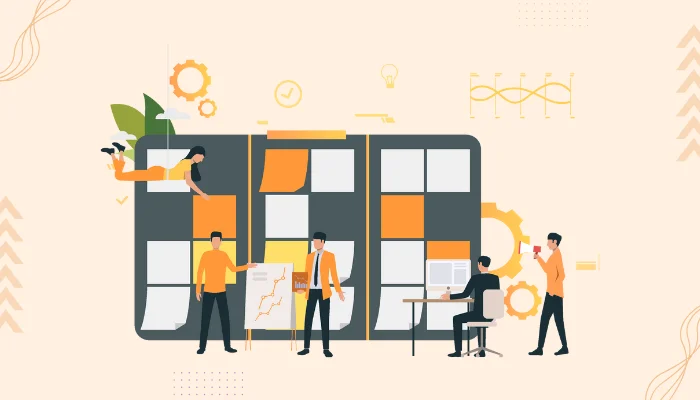
Agile app development is a collaborative, iterative and customer focused approach to software development. Unlike traditional methods, Agile focuses on flexibility, continuous feedback and adaptive responses to changing requirements.
Moreover, it allows development teams to break down complex projects into manageable tasks and deliver functional increments at the end of each iteration.
Best thing about Agile methodology is that companies feel confident enough about their applications since testing is performed thoroughly in the development phase.
In addition, Agile has replaces waterfall as it is most popular development methodology in most companies. Also it is created in 2001 and outlines the four main values and twelve Agile development principles.
Here are those four main values that gave you insights about the main pillars of Methodology.
- Interaction and individuals over the processes and tools
- Working Software over comprehensive documentation
- Customer collaboration over contract negotiation
- Responding to change over following a plan
12 Principles Of Aglie
Agile development process is incomplete without Agile Manifesto outlined as 12 core principles for development process. Take a look.
| 1. Customer satisfaction | The highest priority is to satisfy the customer through early and continuous delivery of valuable software. |
| 2. Welcome changes | Welcome changing requirements, even late in development. Agile processes harness change for the customer’s competitive advantage. |
| 3. Frequent delivery | Delivery working software frequently with a preferences for shorter timescale, ensuring a consistent pace of progress. |
| 4. Collaboration | Business people and developers must work together daily throughout the project. |
| 5. Build projects around motivated individuals | Give them the environment and support they need, and trust them to get the job done. |
| 6. F2F communication | The most efficient and effective method of conveying information is face-to-face conversation. |
| 7. Working software | Working software is the primary measure of progress. |
| 8. Sustainable development | Agile processes promote sustainable development. The sponsors, developers, and users should be able to maintain a constant pace indefinitely. |
| 9. Continous attention to technical excellence | Continuous attention to technical excellence and good design enhances agility. |
| 10. Simplicity | The art of maximizing the amount of work not done is essential. |
| 11. Self-organization | The best architectures, requirements, and designs emerge from self-organizing teams. |
| 12. Regular, reflection and adaptation | At regular intervals, the team reflects on how to become more effective, then adjusts its behavior accordingly. |
Benefits Of Agile Development Methodology
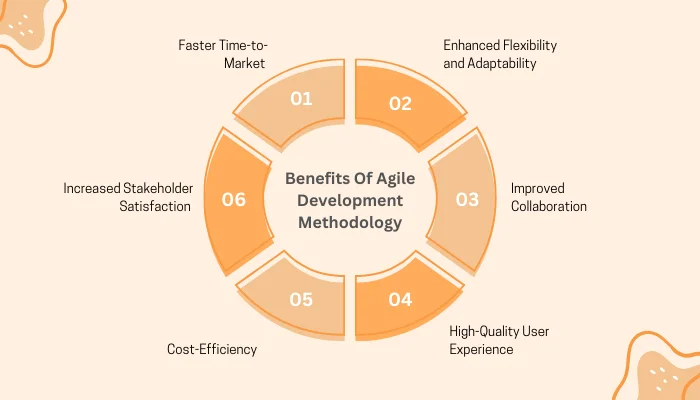
Benefits Of Agile Development Methodology
Agile application development is an established concept. But why should you use it? Well, there are a lot of benefits that comes with agile development methodology.
We shall be discussing all you need to know about that in this section of the blog. i.e. benefits of agile development methodology are, as mentioned below:
Faster Time-to-Market
Let’s start with the first one!
One of the benefits agile methodology offers is faster time to market. What happens is. Agile’s iterative cycles allow for the rapid development and deployment of app features.
Furthermore, the methodology allows development process to be divided into sprints. This allows businesses to release functional components sooner, ensuring they stay ahead in the market.
Enhanced Flexibility and Adaptability
Everyone can appreciate flexibility in development process. And Agile development embraces change.
When it comes to mobile app development, Agile being iterative in nature enables app developers to adapt the app based on real-time feedback as well as changing market demands.
Improved Collaboration
This is yet another big benefit you get with agile methodology.
You see, the particular development methodology we are talking about, allows high-level collaboration.
Look at it like this: app development required seamless blend of design, development, and user experience. And that’s three different things.
To create a successful app, you need to mobile app developers to work on them, collaborating if you want to create a successful platform.
Consequently, the collaborative environment in agile methodology ensures everyone is on the same page.
Thus, leading to a cohesive and user-friendly app.
High-Quality User Experience
There are no two say about the importance of user experience in mobile application. And that’s exactly why agile app development methodology is such a good choice.
This is done by focusing on continuous testing and user validation. Thus, Agile ensures the app is not just functional but also intuitive and user-friendly.
Cost-Efficiency
And at last, one of the big reason to go for agile methodology is, it’s super cost effective. Incremental approach of agile helps manage costs effectively in case of mobile app development.
Like we discussed, agile allows us to break down project into smaller iterations. Thus, businesses can allocate resources strategically, focusing on the most crucial features first.
Moreover, this approach minimizes wastage of resources and budget, ensuring a higher return on investment (ROI) in the long run.
Agile methodology Vs. traditional methodology
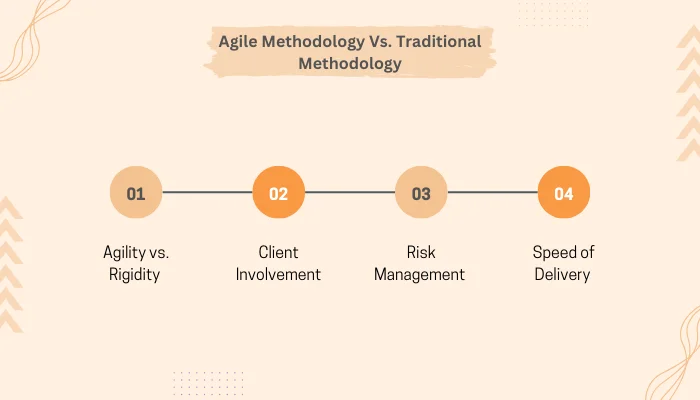
Agile methodology Vs. traditional methodology
Well, well, when you are choosing something there’s always comparison. And in this case, it’s agile vs traditional methodology.
To clear this out for you, let’s explore the difference between them, focusing on the context of mobile app development.
Therefore, let’s get right into it:
Agility vs. Rigidity
Let’s start with the biggest factor. Agility vs rigidity.
Agile methodology allows for changes even later steps. Thus, it ensures the app can adapt to evolving user needs.
On the other hand, the traditional methodology struggles to accommodate changes once the project is underway.
Client Involvement
Client likes to be involved in their project.
Starting with the agile, it allows a great deal of client involvement and feedback. This makes it easier for develop to align and collaborate with the clients.
In contrast, traditional methods often limit client input to the initial requirements phase.
Risk Management
Lastly, let’s look at risk management.
Getting at it, agile uses continuous testing and adaptation to mitigates risks, addressing potential issues early.
Coming to the Traditional methods. it may encounter significant challenges if unexpected issues arise late in the project.
Speed of Delivery
Agile’s iterative approach allows for quicker delivery of functional components. Traditional methods, due to their sequential nature, often result in longer development timelines.
How does Agile development Work?
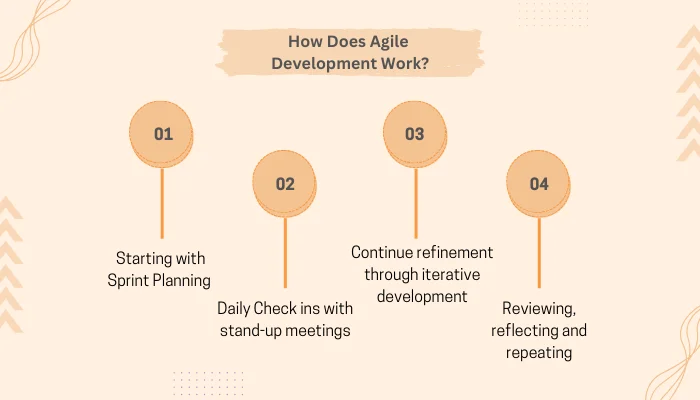
How does Agile development Work?
Agile development is like building the puzzle- it starts with understanding the big picture and then putting together the pieces, one by one.
In laymen terms, Agile is a way of making software where the team works on small oarts of a project at a time, making sure everything fits together seamlessly.
Take a look at the working of the Agile development:
Starting with Sprint Planning
Imagine each task as a mini-project called a sprint. The team plays what they’ll work on in each sprint, priotizing tasks based on their importance.
Think of this as laying out the ingredients before starting to cook-having everything ready ensures a smooth process. Using SEO-friendly keywords in your planning discussions helps search engines understand the content relevance.
Daily Check ins with stand-up meetings
Every day, the team gathers for a quick stand-up meeting. It’s like having a morning huddle to coordinate efforts. These meetings encourage open communication, making sure everyone is on the same page. In the digital world, this collaboration helps search engines recognize your content as cohesive and valuable.
Continue refinement through iterative development
Agile development emphasizes constant improvement. Teams work on their tasks, receive feedback, and make necessary changes. It’s like polishing a diamond – each iteration brings the project closer to perfection.
Reviewing, reflecting and repeating
After completing tasks, the team reviews the work with stakeholders. Feedback is collected and integrated, ensuring the project aligns with expectations. This iterative cycle continues, helping the project evolve.
The Agile Methodology, Scrum Agile, Kanban: What’s the Difference?
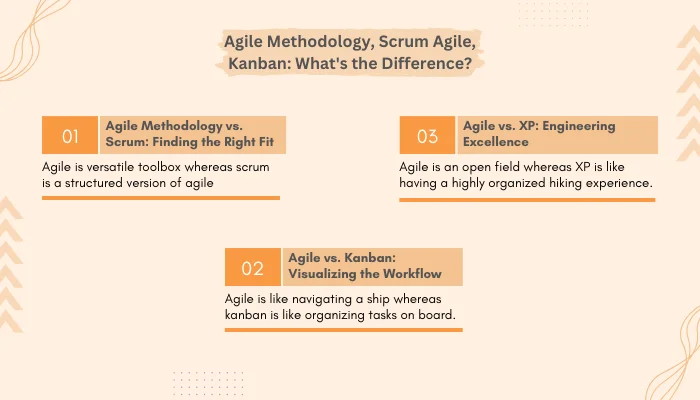
Agile Methodology, Scrum Agile, Kanban Difference
Agile Methodology vs. Scrum: Finding the Right Fit
When it comes to managing projects, Agile and Scrum are two approaches that often come up. Let’s compare them to help you decide which one suits your needs.
Agile Methodology
Agile is like a versatile toolbox. It’s all about adapting to changes, focusing on delivering value in small increments. Imagine you’re building a house, and you can adjust the design as you go, making sure it meets your needs.
Scrum
Scrum, on the other hand, is a more structured version of Agile. It’s like having a daily agenda for your tasks. You plan sprints (short work cycles), execute them, and then review your progress. Think of it as having milestones on your construction project to measure how much you’ve built.
Agile vs. Kanban: Visualizing the Workflow
Now, let’s compare Agile to another popular approach, Kanban.
Agile Methodology
Agile is all about flexibility and customer satisfaction. It’s like navigating a ship, adjusting your course based on changing sea conditions. You can switch directions quickly if you spot a better route.
Kanban
Kanban is like organizing tasks on a board. You have cards representing tasks, and you move them through columns as you progress. It’s like managing a to-do list, checking off items one by one, with a clear visual of what’s pending and what’s done.
Agile vs. XP (Extreme Programming): Engineering Excellence
Lastly, let’s explore how Agile compares to Extreme Programming (XP).
Agile Methodology
Agile is like an open field where you have freedom to adapt and choose how to approach your journey. It’s like planning a camping trip where you decide when to set up camp, hike, or explore, depending on the terrain and weather.
XP (Extreme Programming)
XP is a specific methodology within Agile. It’s like having a highly organized hiking expedition. You follow a strict plan with defined roles, like who leads the group, navigates, or sets up camp. XP emphasizes practices such as pair programming and continuous testing to ensure high-quality results.
In summary, choosing between Agile, Scrum, Kanban, or XP depends on your project’s nature and requirements. Agile offers adaptability, Scrum provides structure, Kanban focuses on visualizing workflow, and XP emphasizes engineering practices. Consider your project’s terrain and goals to make the right choice.
Conclusion
When it comes to software development Agile methodologies isn’t a choice its necessity.With this blog we hope that you can headfirst into the world of agile, ready to transform your development processes, one sprint at a time.
If you are ready to transform your development process, start your Agile journey with us. Let’s collaborate, learn and grow together. Feel free to contact us.
FAQs
Agile application development is an iterative and flexible approach to building software. It prioritizes customer feedback, collaboration, and the delivery of small, functional increments of the application.
Agile principles include customer collaboration, responding to change, delivering working software frequently, and valuing individuals and interactions over processes and tools.
The choice depends on your project’s needs. Scrum is structured with fixed-length sprints, while Kanban provides a more continuous flow. Consider your project’s size, complexity, and team dynamics when choosing.
Transitioning to Agile requires training, coaching, and a cultural shift. Start with educating your team on Agile principles, and gradually implement Agile practices while continuously seeking feedback and improvement.
Popular Agile tools include Jira, Trello, and Asana for project management, and tools like Jenkins and Travis CI for continuous integration and delivery.
Agile welcomes changing requirements, even late in development. Through frequent customer feedback and iterative development, Agile allows you to adapt to changing needs.
Benefits include faster time-to-market, improved customer satisfaction, better quality software, and increased adaptability to market changes.
The Product Owner is responsible for defining and prioritizing the product backlog, ensuring the team works on the most valuable features for the customer.

Niketan Sharma is the CTO of Nimble AppGenie, a prominent website and mobile app development company in the USA that is delivering excellence with a commitment to boosting business growth & maximizing customer satisfaction. He is a highly motivated individual who helps SMEs and startups grow in this dynamic market with the latest technology and innovation.
Table of Contents












No Comments
Comments are closed.